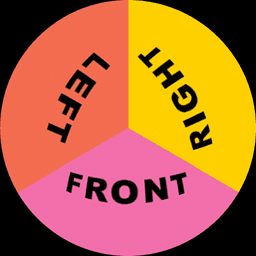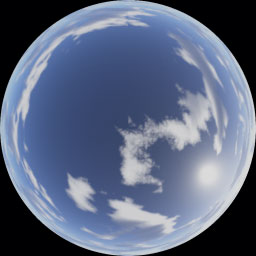
Stitching Methods <2>
-The dome masters on this page were stitched by TriStitcher-
In the cubic camera alignments, six squares cover all directions. Instead of a cube,
a regular tetrahedron can be used. In this case, four regular triangles cover all directions,
and you can reduce the number of rendering times. To cover a half-world, or hemisphere,
three faces are necessary and sufficient. Three cameras (front, left, and right)
in the tetrahedral alignment are enough to cover the world in tridivision.
Tetrahedral Camera Alignment

Tridivision Alignment
Three cameras are set at 120-degree intervals.
The elevation angle of each camera is 45 degrees,
which minimizes the area discarded in stitching.
As a result, the aspect ratio of each shot is one (90 degrees)
to square root of six (about 135.59 degrees).

TRI(3)DIVISION
the least number of rendereng times needed to cover a hemisphere
no seams in front
large area (half of each of the original image) discarded in stitching
(Put the cursor over the image to see discarded areas.)
larger distortion in the peripheral part of the original images
BEFORE STITCHING
Shaded areas are unused and discarded in stitching.

STITCHED IMAGE -stitched by TriStitcher
Considering 50% of the scrappage rate and the peripheral distortion,
tridivision is not the best choice of the stitching methods.
The wide 136-degree FOV, however, may be useful when one or two shots
out of three are used without being stitched. Put the cursor over the image.
DOWNLOAD OF TRISTITCHER
You can download TriStitcher by clicking the button below.
TriStitcher is a Windows application.
Only Truevision TGA (Targa) files are acceptable as source files.
If you input any "Start number," the source is regarded as sequential files.
The output file format is RLE-compressed 24 or 32-bit Truevision TGA.
Only if you check "Save alpha channel," the output files will be saved in 32-bit-bit.
Copyright 2004-2011 © PineappleWare All rights reserved.